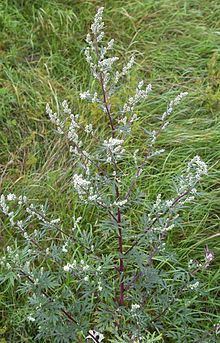Scientific name Artemisia vulgaris Rank Species | Genus Artemisia Higher classification Mugworts | |
 | ||
Similar Mugworts, Common wormwood, Yarrow, Annual ragweed, Ribwort Plantain | ||
Artemisia vulgaris cronewort with herbalist susun weed
Artemisia vulgaris (mugwort or common wormwood) is one of several species in the genus Artemisia commonly known as mugwort, although Artemisia vulgaris is the species most often called mugwort. This species is also occasionally known as riverside wormwood, felon herb, chrysanthemum weed, wild wormwood, old Uncle Henry, sailor's tobacco, naughty man, old man or St. John's plant (not to be confused with St John's wort). Mugworts have been used medicinally and as culinary herbs.
Contents
- Artemisia vulgaris cronewort with herbalist susun weed
- Artemisia vulgaris mugwort
- Distribution
- Description
- References
Artemisia vulgaris mugwort
Distribution
Artemisia vulgaris is native to temperate Europe, Asia, northern Africa and Alaska and is naturalized in North America, where some consider it an invasive weed. It is a very common plant growing on nitrogenous soils, like weedy and uncultivated areas, such as waste places and roadsides.
Description
Artemisia vulgaris is a tall herbaceous perennial plant growing 1–2 m (rarely 2.5 m) tall, with a woody root. The leaves are 5–20 cm long, dark green, pinnate and sessile, with dense white tomentose hairs on the underside. The erect stems are grooved and often have a red-purplish tinge. The rather small florets (5 mm long) are radially symmetrical with many yellow or dark red petals. The narrow and numerous capitula (flower heads), all fertile, spread out in racemose panicles. It flowers from mid-summer to early autumn.
A number of species of Lepidoptera (butterflies and moths) feed on the leaves and flowers.
